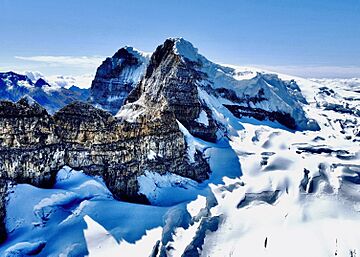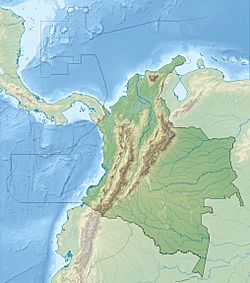Ritacuba Negro facts for kids
Quick facts for kids Ritacuba Negro |
|
|---|---|

North aspect, centered
(Ritacuba Blanco behind) |
|
| Highest point | |
| Elevation | 5,340 m (17,520 ft) |
| Prominence | 212 m (696 ft) |
| Isolation | 0.65 km (0.40 mi) |
| Parent peak | Ritacuba Blanco |
| Geography | |
| Country | Colombia |
| Department | Boyacá |
| Parent range | Andes Cordillera Oriental |
| Protected area | El Cocuy National Park |
| Topo map | CIGM Sheet 137 El Cocuy |
| Climbing | |
| Easiest route | Southwest Ridge |
Ritacuba Negro is a magnificent mountain located in the Boyacá Department of Colombia. It is a truly impressive natural landmark, known for its towering height and stunning views. This peak is an important part of the Andes mountain range, which stretches across South America.
Contents
Discovering Ritacuba Negro: A Colombian Mountain
Ritacuba Negro stands proudly in Colombia, inviting adventurers and nature lovers to explore its unique environment. It is a place where nature's power and beauty are clearly visible.
Where is Ritacuba Negro?
This impressive mountain is found in the eastern part of Colombia. It is part of the Cordillera Oriental, which is a large section of the famous Andes mountains. Think of the Andes as a giant backbone running down South America, and the Cordillera Oriental is one of its important branches. Ritacuba Negro is also located inside the beautiful El Cocuy National Park, a protected area known for its incredible landscapes and wildlife.
How Tall is Ritacuba Negro?
Ritacuba Negro reaches an amazing height of 5,340 meters (about 17,520 feet) above sea level. This makes it one of the tallest mountains in the region! In fact, it is the second-highest peak within El Cocuy National Park and in the entire Boyacá Department. It also ranks as the 10th-highest mountain in all of Colombia. The mountain rises very steeply, climbing 940 meters (over 3,000 feet) in just two kilometers on its eastern side. The closest taller mountain is Ritacuba Blanco, which is about 1.12 kilometers (0.69 miles) away to the southeast.
Water from the Mountain: Rivers and Watersheds
Mountains like Ritacuba Negro play a vital role in providing water. Rain and melting snow from the mountain's western slopes flow into smaller streams. These streams eventually join the Chicamocha River. On the eastern side, water flows into the Arauca River. The Arauca River is part of a much larger system called the Orinoco watershed. A watershed is like a giant basin where all the water from rain and snow eventually drains into one main river or lake. So, Ritacuba Negro helps feed two important river systems in Colombia!
First Climbers of Ritacuba Negro
Reaching the top of a mountain like Ritacuba Negro is a big achievement. The first time Colombian climbers successfully reached the summit of Ritacuba Negro was on March 26, 1975. These brave climbers were Pepe Luis Moreno and Sergio Gaviria. Their ascent marked an important moment in Colombian mountaineering history.
The Climate of Ritacuba Negro
The weather and climate around Ritacuba Negro are very special because of its high elevation.
Understanding the Mountain's Weather
Ritacuba Negro experiences what is called a tundra climate. This type of climate is usually found in very cold regions, often near the poles or on high mountains. It's part of a zone known as the "tierra fría" in Spanish, meaning "cold land." In this area, the air is pushed upwards by the mountains. This process, called orographic lift, causes the moisture in the air to cool down and fall as rain or snow. This is why high mountains often have a lot of precipitation.
The Ritacuba Glacier and Climate Change
The cold climate on Ritacuba Negro supports a glacier, which is a large, slow-moving river of ice, on its western slope. However, this glacier is currently melting at a fast rate. This melting is happening because of climate change, which refers to long-term shifts in global weather patterns. Natural events like El Niño, a climate pattern that warms parts of the Pacific Ocean, can also affect the glacier's size. Scientists are studying these changes to understand their impact on the environment.
Best Times to Visit Ritacuba Negro
If you ever dream of visiting this incredible area, the months of September, December, and January usually offer the best weather. During these times, the conditions are often more favorable for exploring the stunning landscapes around Ritacuba Negro.
Gallery
See also
- Sierra Nevada del Cocuy
- List of mountains in Colombia




